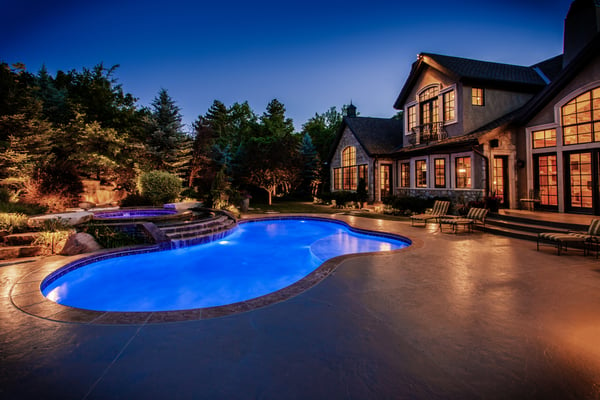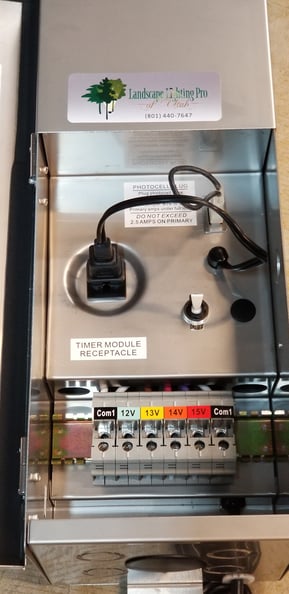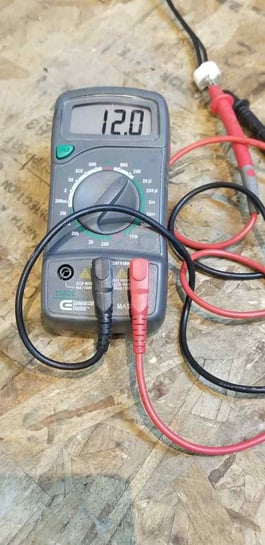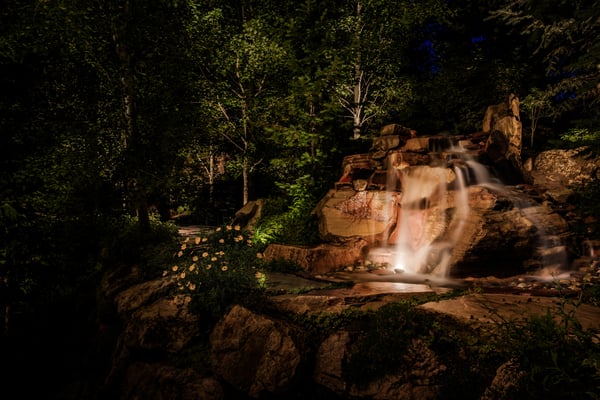Myths: Wiring low-voltage landscape transformers & LED lighting systems
There is a lot that goes into the technical side of how a low-voltage lighting system works and operates. Recently a client asked me a specific question about the technical side of his system.
He wanted to know why his transformer was wired to the 12v terminal instead of the 14v. If it feels like we already jumped from 0-60, don’t worry!
There isn’t a quiz at the end.
This question made me realize that this was a topic we haven’t covered yet, but really ought to!
Low-voltage lighting requires engineering
A well-engineered low-voltage lighting system has to have balanced wire runs that are wired for an appropriate voltage load.
What does this mean exactly?
It means that the wires need to be run in such a way that they distribute power as evenly as possible between each fixture. In addition, the lines need to be wired into the transformer in a way that sends the right amount of power down the line to each fixture.
Let’s take a look at what all this means & how it all works.

Wire runs & transformers
For simplicity, let’s break this up into two parts: wire runs and transformer loads.
Wire Runs
The way the lines are run has a significant impact on the performance of the system and how power is distributed.
A low-voltage lighting system can be compared to a sprinkler system.
In a sprinkler system, the water pressure decreases as more sprinkler heads are added to the water line.
The same is true for low-voltage lights. The more fixtures you add to a wire run, the more the voltage decreases. This is known as a voltage drop.
Voltage drops are undesirable, but having the voltage too high is also undesirable. If you place too many fixtures on one wire run, the voltage will be poorly distributed, making it difficult for each light to receive enough power.
It is also important to note that daisy chaining light fixtures will produce poor results. Daisy chaining is the process of connecting multiple fixtures together in a line.
This can cause a significant voltage drop, especially if the wire run is long.
The best way to distribute power evenly is to split the wire runs down the middle and center-feed them. This ensures that each fixture receives equal power, regardless of its location on the wire run.
Transformers

The transformer is a metal box that provides power to the entire lighting system.
In a small, 75-watt transformer, you will typically find two terminals: one labeled “common” and one labeled “12V.” Landscape lighting uses direct burial cable, which has two wires. One wire is connected to the common terminal, and the other wire is connected to the 12V tap.
The wiring is pretty straightforward in a small lighting system.
However, the number of terminal blocks and commons can vary depending on the size of the transformer.
For example, a 300-watt transformer may have terminals with different voltages, such as 12V, 13V, 14V, 15V, or even higher. It may also have two common terminals.
The reason a larger transformer has more terminals and commons is that it is designed to power a larger system.
In a large or long run of lights, the voltage can be boosted by moving the wire to a terminal with a higher voltage. This compensates for voltage drops caused by longer distances and higher light counts. This is why there are different terminal blocks to distribute different levels of voltage to the system.
Voltage Drops: How do we know?
The great thing about being able to boost power is that if the last light in a run doesn’t have enough power, we can simply boost the line until it does.
But how do we know if get enough power? Contrary to popular belief we don’t discover the voltage a fixture is getting by reading shadows or listening to crickets. We find out the voltage by using a voltage meter. By checking the voltage of each light in the wire run, we can dial in the voltage to be exactly where we need it.
Plain & simple: if the person installing/working on your lighting system doesn’t know how to use a voltmeter, you should be wary. Our experience is they don’t even carry a voltage meter in their toolbox. It’s always a good idea to go with a professional.
Do LED Lights take all the complication out of landscape lighting, or do they perpetuate a myth?

In recent years, LED lamps have become a standard in the lighting industry: as well they should be. They are incredibly energy efficient with awesome life spans of up to 50,000 hours (that’s around 15 – 20 years of lamp life) While LED is more expensive, they are well worth the price.
In the world of low voltage landscape lighting, LED lamps have also become prevalent. In fact, they have allowed us to create larger lighting systems, often, without the need for larger transformers. In addition, LED lamps will turn on at both higher and lower voltages without having their brightness affected like old school halogen lamps would.
LED lights also give lighting designers greater controllability over the effects they are looking to create. Without the need for larger transformers that require more involved planning & engineering, LED lamps have also brought a strange myth to landscape lighting: that landscape lighting is simple & easy to do.
The myth
This myth couldn’t be further from the truth. Many lighting systems out there are being built with disregard for sound & established engineering practices. Everything learned in the days of halogen still need to be applied today. Just because LED is here, doesn’t mean tried & true practices should be neglected or forgotten.
The voltage requirements for a system can be all over the place. We’ve learned in our, own experience, that this doesn’t go well for LED lamps when they aren’t calculated to be as close to 12V or 11.5V as possible. Inside an LED lamp is a driver that, depending on specific lamp and manufacturer, will all the LED to operate and function within a wide range of different voltage loads.
But that doesn’t mean the system should be run at peak output simply because it can. Running a lighting system at it’s highest voltage is what tends to happen when a system needs to send enough power to the last fixture in a long run of daisy chained LED lights.
In our experience, LED lamps that are powered too high or too low tend to have a shortened life. For the price LED lamps cost, wouldn’t you want to get the full lifespan out of them? The internal pieces that make the LED work are forced to work harder when more or less power than 12V is being fed to them.

But the LED lamps will still work when the system is first plugged in & will likely continue working. But when a system isn’t properly installed & fine tuned, it doesn’t tend to last. If the voltage loads weren’t done properly, who knows what other aspects of the system could have been passed over or skipped for a short-cut.
Properly wiring the transformer and running center fed wires to fixtures at the correct voltage is one of the most overlooked pieces in the building of low voltage landscape lighting systems today. It’s important that a landscape lighting system be engineered well to assure the longevity and continued enjoyment homeowners will experience.
*We’d like to send out a special thanks to Kevin Smith with Brilliance LED for sharing his years of insight in the landscape lighting industry with us.
Give us a call
To learn more about how down lighting and uplighting can work together to beautify your landscape, call us at (801) 440-7647 to schedule a free consultation, or, simply fill out our contact form!
Located in Midvale, Landscape Lighting Pro of Utah serves customers throughout Utah’s residential areas, including Salt Lake City, Park City, Draper, and Holladay. Our outdoor lighting portfolio includes projects from Salt Lake County and Utah County, to Davis County and Summit County — and beyond.
Salt Lake City (Midvale)
801-440-7647
St. George
435-932-6627
©2025 Landscape Lighting Pro
Privacy Policy
Cookie Policy